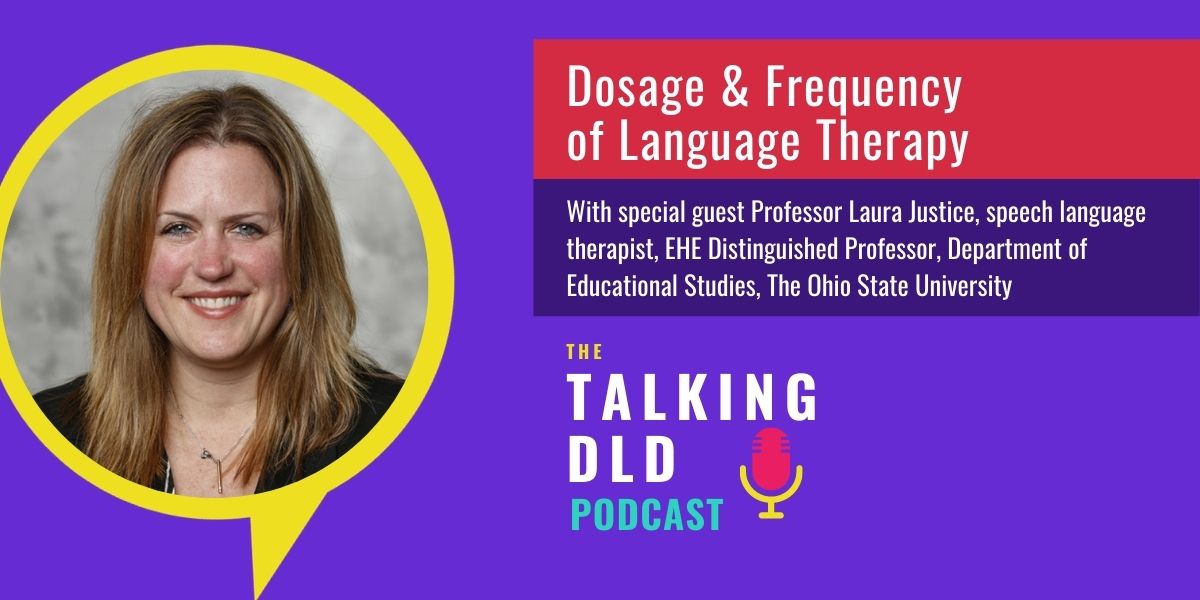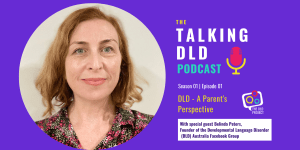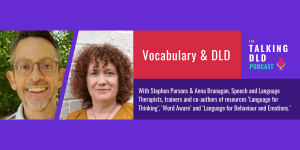In this episode of The Talking DLD Podcast we are tackling the big one – Dosage and Frequency of Language Therapy for children with DLD.
Our special guest is Professor Laura Justice, speech language therapist and EHE Distinguished Professor, Department of Educational Studies at The Ohio State University. Laura is well known and respected for her research into language therapy.
" We don’t need to see kids 3 to 5 times a week. We just need to be fiercely productive when we are with the kids."
Professor Laura Justice Tweet
More about Professor Laura Justice's Work
Professor Justice’s current research interests focus on young children who exhibit developmental vulnerabilities in language and literacy acquisition. Much of the research considers the effects of teacher or parent implemented interventions on children’s learning, including the effective use of storybooks.
Professor Justice is also interested in the state of classroom quality in early childhood and how various aspects of quality affects children’s gains with the classroom. As a clinically-certified speech-language pathologist, she also maintains a strong interest on children with Developmental Language Disorder (DLD) previously known as speech/language impairment (SLI), and she is involved with several studies examining emergent literacy development among children with DLD / SLI.
Publications
- Justice, L. M., & Pence, K. (2005). Scaffolding with Storybooks: A Guide for Enhancing Young Children’s Language and Literacy Achievement. Newark, DE: International Reading Association.
- Ezell, H. K. & Justice, L. M. (2005). Shared Storybook Reading: Building Young Children’s Language and Emergent Literacy Skills. Baltimore, MD: Paul H. Brookes.
- Justice, L. M. (2006). Communication Science and Disorders: An Introduction. Upper Saddle River, NJ: Merrill Prentice Hall.
- Justice, L. M. (Ed) (2006). Clinical Approaches to Emergent Literacy Intervention. San Diego, CA: Plural Publishing.
- Pence, K., & Justice, L. M. (2007). Language Development: Theory to Practice. Upper Saddle River, NJ: Merrill Prentice Hall.
- Justice, L. M., Meier, J., & Walpole, S. (2005). Learning new words from storybooks: Findings from an intervention with at-risk kindergarteners. Language, Speech, and Hearing Services in Schools, 36, 17-32.
- Justice, L. M., Kaderavek, J., Bowles, R., & Grimm, K. (2005). Phonological awareness, language impairment, and parent-child shared reading: A feasibility study. Topics in Early Childhood Special Education, 25, 143-156.
- Justice, L. M., Bowles, R., Kaderavek, J. K., Ukrainetz, T., Eisenberg, S., & Gillam, R. (2006). The Index of Narrative Micro-Structure (INMIS): A clinical tool for analyzing school-aged children’s narrative performance. American Journal of Speech-Language Pathology, 15, 1-15.
- Justice, L. M., Skibbe, L., & Bowles, R. (2006). Measuring preschool attainment of print concepts: A study of typical and at-risk 3- to 5-year-old children. Language, Speech, and Hearing Services in Schools, 37, 1-12.
- Justice, L. M. (2006). Evidence-based practice, response-to-intervention, and prevention of reading difficulties. Language, Speech, and Hearing Services in Schools, 37, 1-14.
- Justice, L. M., Pence, K., Bowles, R., & Wiggins, A. K. (2006). An investigation of four hypotheses concerning the order by which 4-year-old children learn the alphabet letters. Early Childhood Research Quarterly, 21, 374-389.
- Justice, L. M., Sofka, A., & McGinty, A. (2007). Targets, techniques, and treatment contexts in emergent literacy intervention. Seminars in Speech and Hearing, 28, 14-24.




Thanks for sharing amazing information.
LOVED This episode and love your podcast! My pile of articles to read just keep getting bigger… haha!